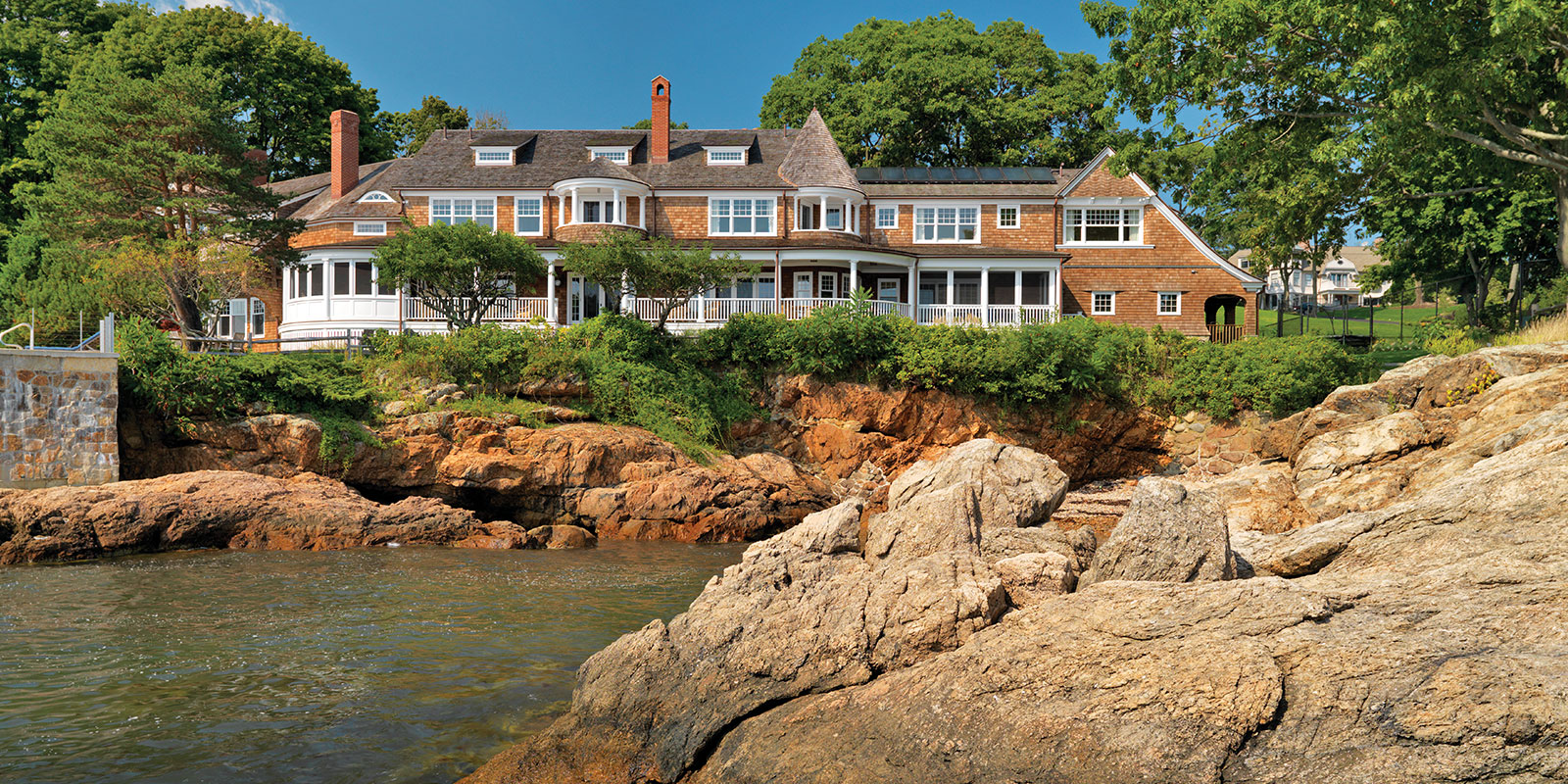As striking as a coastal home can be on first glance, sometimes it is the details that tip it to breathtakingly beautiful. One such house is OakLedge in Manchester-by-the-Sea, Mass.
Set on an oceanfront rocky outcrop, its shingled cladding shining in the sunlight, the home achieves that elusive stature of appearing delicate in its artisanship yet formidable enough to withstand anything the Atlantic Ocean can throw at it.
The home, designed and constructed by Carpenter & MacNeille Architects and Builders in nearby Essex, is a New England classic, reflecting the late 1880s heyday of Shingle-style architecture.
Eyebrow dormers, artisanal millwork and decorative shingle patterns punctuated by unique shingle voids give the home a powerful, distinctive appearance.
The condition of the original house on the property was too poor to save it entirely, although some features, including much of the foundation, remain.
“The original structure was a cow barn, a small cottage that was originally built in 1873,” says Michael T. Gray, AIA, managing director of Carpenter & MacNeille and the project director.
“The structure had grown over the years and became a long rectangular house.” Gray and his colleagues also retained an entire wing, added in 1896 and called the Music Room. “It became the living room,” Gray says.
While the exterior fits seamlessly with the area’s historic character, many of the materials and techniques are new. The floor plan has some modern features to suit the needs of the homeowners, who have two children.
Unseen, but significant, is an innovative 21st-century geothermal and solar mechanical system, that supplies hot water to heat the swimming pool and most of the house’s heating and cooling needs.
The home’s interior hums with historic style. The centerpiece of the design is the Living Hall, a traditional Shingle-style space in the front entryway that actually serves as a room.
With a fireplace – crowned by an original mantel – and nearby seating, the hall has a graceful, curved panel archway that frames a water view ahead. “Obviously the ‘wow’ factor walking into the door is the view, looking straight out at the ocean,” Gray says.
In the 19th century, the Living Hall set the tone for Shingle-style homes, Gray says. “People would make it the most elaborate room, because that was the first room guests would see. It’s the first experience of the house.”
Just beyond the archway is the library, a singular space. While an open floor plan is a hallmark of original Shingle style – and radical for its time – the OakLedge layout is more modern, designed for good flow, pleasing sight lines and plenty of sunshine and water views.
Small rooms, including a comfortable study with a handsome paneled mahogany interior and a fireplace surround with hidden doors to contain computer wiring, provide other modern touches.
The interior designer, Ashley Scott of Niles-Scott Interiors of Manchester, Mass., injected shots of color and texture throughout the house with accent pieces, chunky sisal and, as Scott says, “hints of surprise” in lamps and other pieces.
The paneled stair hall’s grand staircase leads to the second-floor landing nook, a quiet space with a pretty decorative stained-glass window by a local Essex artist. The family also loves the new ocean-facing porch, outfitted with a pizza oven and fireplace of stacked granite.
The interior’s custom millwork – such as its beveled wall paneling, staircase and balustrade – was designed and made at Stephen Terhune Woodworking, Carpenter & MacNeille’s own shop.
Housed in a trolley car barn next to the architectural offices, the shop turns out custom millwork, furniture and some of OakLedge’s finest details, such as the wave-patterned shingles over the portico.
A majestic oak tree sweeps a leaf pattern across the shingles and stands in testament to OakLedge, whose name derives from that very tree and the waterside granite ledge. “There’s a lot of movement and texture in the shingles,” Gray says.
The shingle voids (openings in the shingles), which wrap around the front and back of the Music Room and allow light to filter through, are special to Gray.
The architect recalls working on an 1880s house, designed by renowned American architect William Ralph Emerson, which had the same motif.
“Emerson created a rhythm of space in that detail,” Gray says of the shingle voids. “I said to myself, if I ever have the opportunity to do this, I’m going to. It’s one of my favorite details. There’s a lot of character there.”
Some of the home’s original features were used in the new iteration of OakLedge. The foundation stone for the new work is actually veneer granite that was hand cut from the original foundation, Gray says. Tinged orange and brown, the Cape Ann granite (also called Rockport granite) was locally sourced in Manchester.
Another high point of the exterior is the square tower with a brick chimney, made to match the original. “We took it down brick by brick,” explains Gray. “We wanted to recreate that tower.”
Today, the tower stands as a symbol of how OakLedge came to be. As Gray says, “I like to think that if someone who knew the original house came back and saw it years later, they would still recognize it.”
For more information, visit www.carpentermacneille.com
Image Credits: Photo by Richard Mandelkorn.


